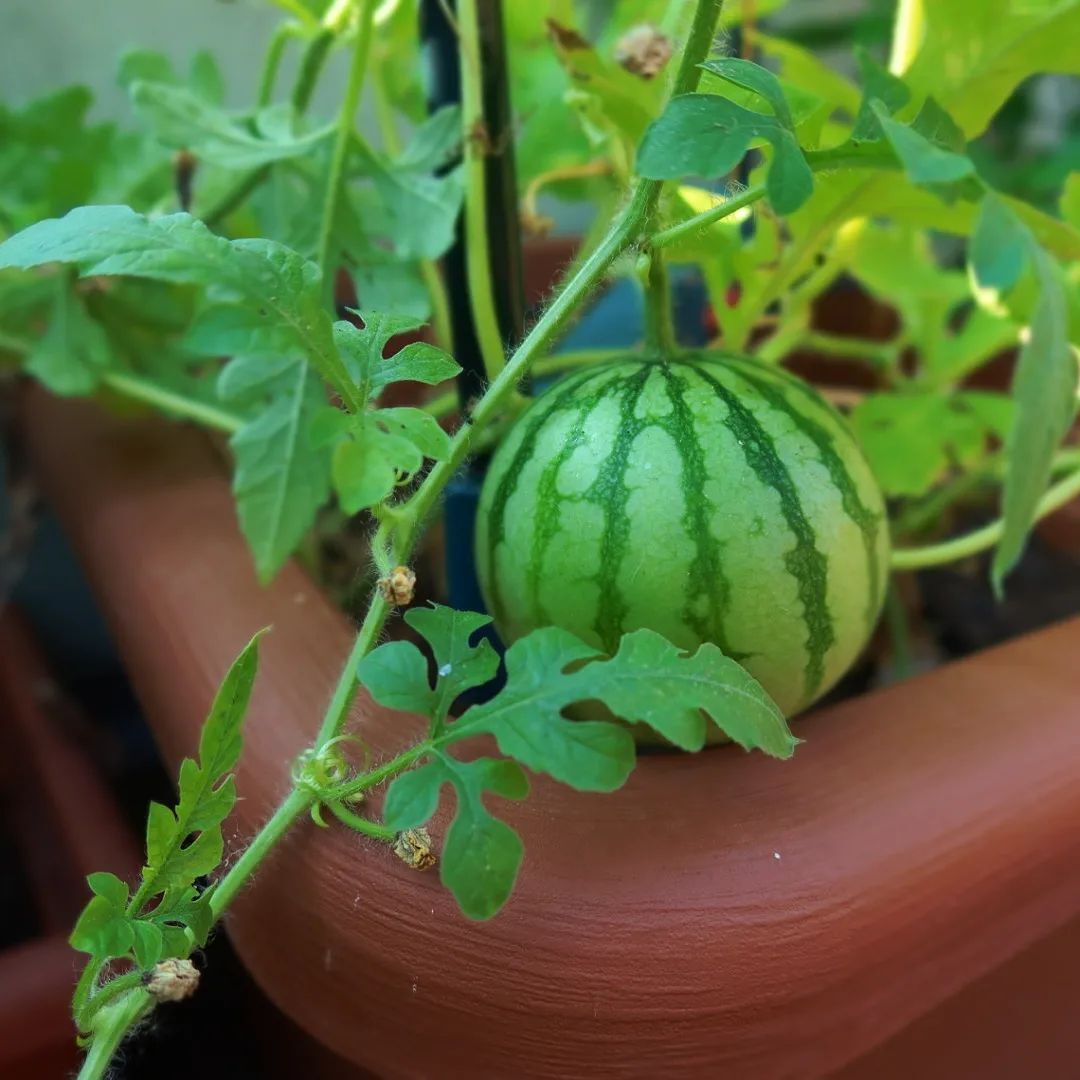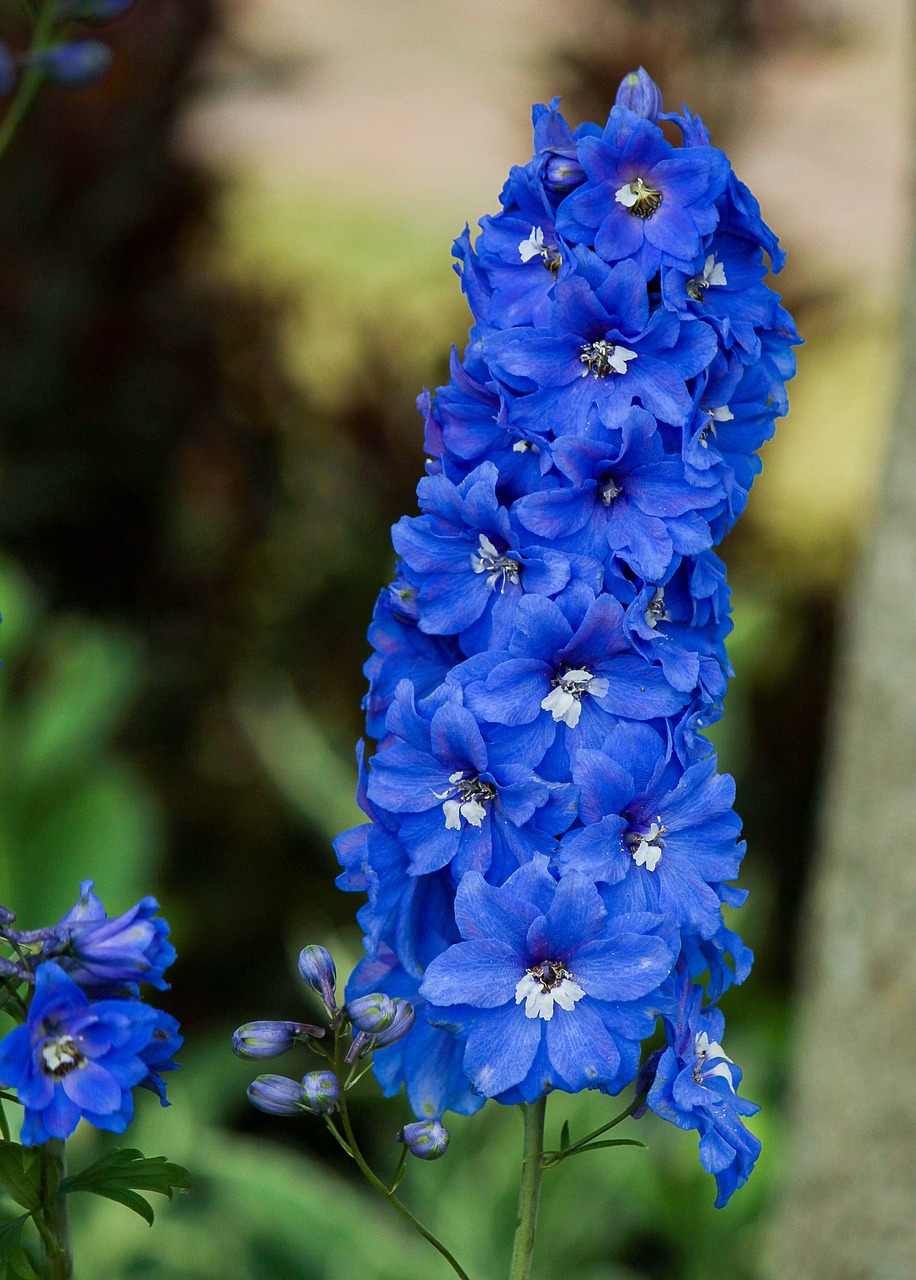Learn Growing Watermelon in a Pot Vertically in compact spaces and enjoy delicious fruit with the help of this comprehensive guide.
Follow this informative post and learn about Growing Watermelon in a Pot Vertically in limited spaces and relish homegrown fruits right from your own container.
Common Name: Watermelon
Botanical Name: Citrillus lunatus
USDA Zones: 2-11 as an annual
Read Kajari Melon Care in Pots and Garden
Watermelon Profile
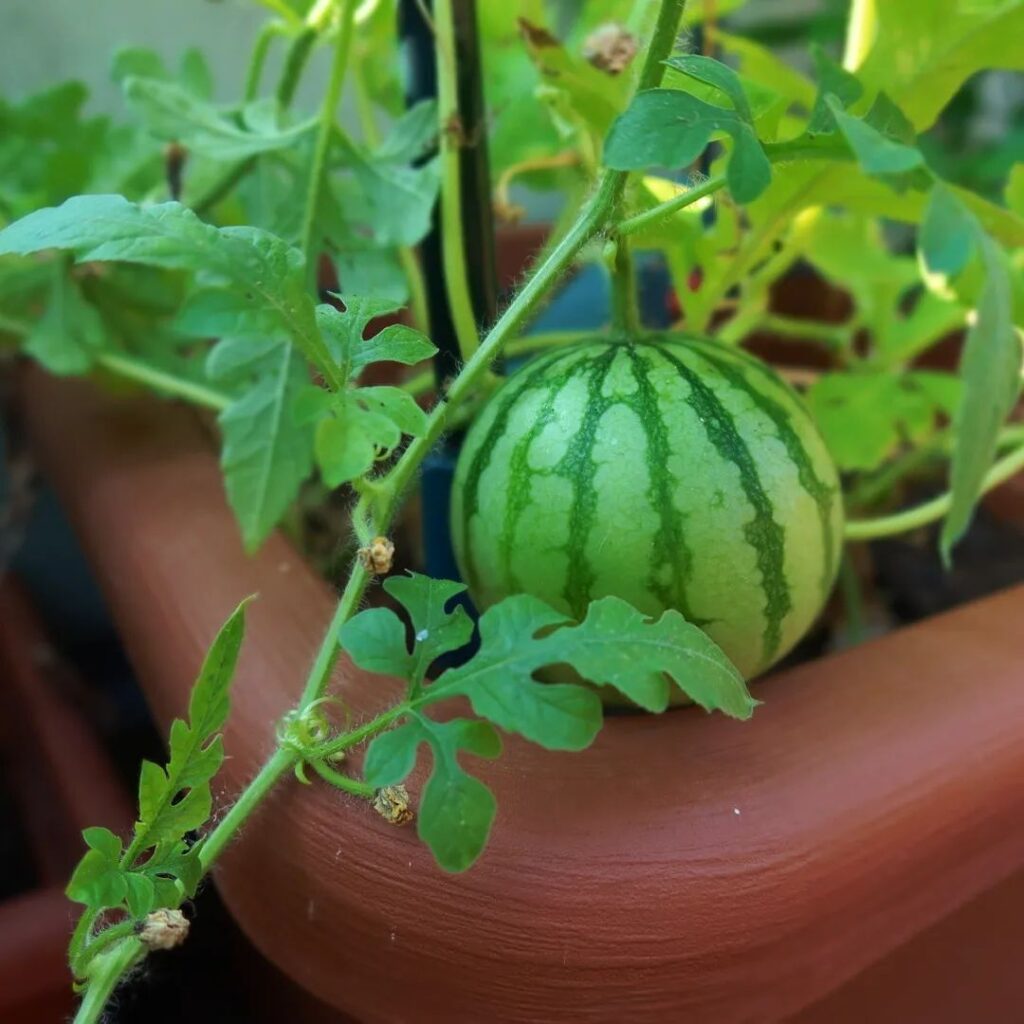
Watermelon, a popular fruit enjoyed during the summer, is a type of annual vine that thrives in a long and hot growing season. It belongs to the extensive Cucurbitaceae family, which includes various vining vegetables like cucumbers, squash, and pumpkins. The watermelons commonly found in home gardens are different cultivars of the Citrillus lunatus species.
The Watermelons have the potential to be grown vertically in pots, allowing for space-saving cultivation and efficient use of limited gardening areas. This method enables gardeners to maximize their harvest while enjoying the sweet, refreshing fruits of their labor.
Benefits of Growing Watermelons Vertically
- Firstly, it optimizes space utilization, making it suitable for small gardens, balconies, or even indoor gardening.
- Vertical growth allows for increased plant density, maximizing the number of watermelons that can be cultivated in a given area.
- This method also aids in better airflow and sunlight exposure, reducing the risk of diseases and promoting healthy growth.
- Vertical gardening makes watering, fertilizing, and harvesting more convenient as the fruits are elevated and easily accessible.
- Additionally, it minimizes the risk of rot or damage caused by direct contact with the ground.
- Overall, vertical cultivation of watermelons offers a practical and efficient approach to enjoying this summertime treat.
Read Tips on Growing Cucumbers Vertically
Propagation and Planting of Watermelon in a Pot
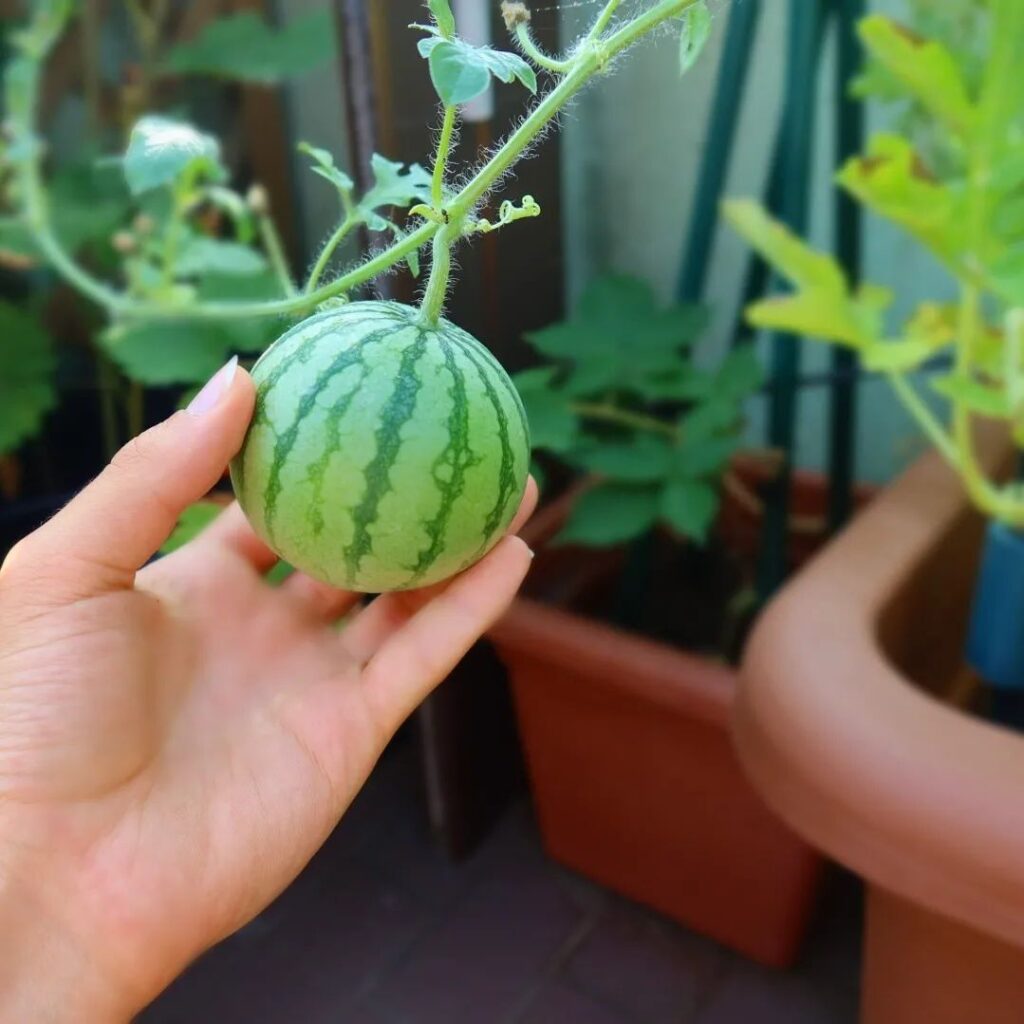
- Due to its long taproot and poor transplanting success, it is advisable to sow watermelon seeds in a pot directly.
- When spring temperatures reach 65 F (19 C) or above, it is recommended to plant 3-4 seeds directly into the desired pot.
- This method ensures better establishment and growth of watermelon plants, allowing them to thrive in the potting environment.
- For regions with warm, frost-free climates (USDA Zone 10-11), the optimal timing for sowing watermelon seeds is during the winter and early to mid-spring.
- Germination typically occurs within a span of 6 to 12 days. Once the seedlings begin to grow, it is recommended to thin them out and retain only the healthiest and strongest saplings per pot.
- This selective process ensures that the remaining plants have ample space and resources to develop and thrive in the pots.
Best Pot for Growing Watermelon
While growing watermelon in containers can be challenging, it is not overly difficult if you grasp the fundamentals. One crucial aspect is selecting a deep pot to accommodate the long taproot of watermelon plants.
Ideally, a spacious container such as a large pot or bucket, at least 2 feet deep and half as wide. It is necessary to provide sufficient room for root development and overall plant growth.
Read Muskmelon vs. Cantaloupe: Differences and Similarities
Best Watermelon Varieties to Grow in Pot
- Gold In Gold
- Solitaire
- Belle 460
- Golden Sunrise
- Gold-N-Sweet
- New Hampshire Golden Midget
- Precious Petite
- Golden Midget
- Red Doll
- Jenny
Growing Watermelon in a Pot Vertically
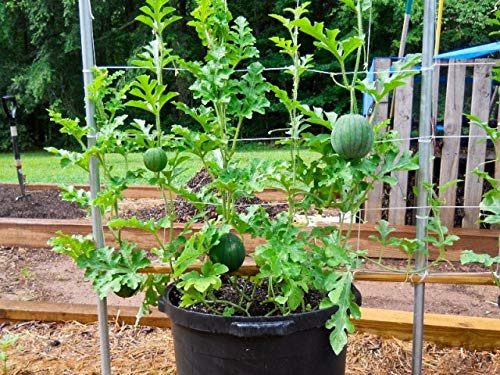
Location
Watermelons thrive best in a sunny location. If you have limited space, such as a balcony or a rooftop garden, growing watermelons vertically on a trellis is an excellent solution.
Soil
Watermelons thrive in sandy and loamy soils, which offer excellent drainage and aeration for optimal plant growth. It is important to ensure that the substrate is well-drained to support the plant’s development. The ideal soil pH for watermelons ranges from 6 to 6.8. On the other hand, it is advisable to avoid compact, clay soils as they can impede proper growth.
To enhance the soil quality and provide a steady supply of nutrients, incorporating well-rotted horse, rabbit, or cow manure is beneficial. This organic matter not only improves the texture of the soil but also nourishes the watermelon plants throughout their growth cycle.
Water
Watermelon plants have high water requirements, demanding the maintenance of consistently moist soil. However, it is important to avoid overwatering and ensure proper drainage.
When growing watermelons in containers under full sun, daily watering is necessary, and on warm summer days, it may be required twice a day. As the fruits begin to develop and ripen, it is advisable to reduce the frequency of watering.
During this period, exercise caution and water the plants moderately. It is crucial to strike a balance and avoid both overwatering and underwatering to achieve the sweetest-tasting melons.
Temperature
Watermelons are annual plants that thrive in warm climates, making them suitable for both tropical and temperate regions. They can be successfully grown within a temperature range of approximately 50-95°F (10-35°C). However, the optimal growing temperature for watermelons is between 65-85°F (18-30°C).
Read Tips to Grow a Papaya Tree
Watermelon Plant Care

Fertilizer
Begin the fertilization process for the watermelon plant using a liquid fertilizer. Once the plant enters the flowering stage and starts to produce fruits, it is recommended to switch to a fertilizer with lower nitrogen content. An excellent option to consider is liquid seaweed fertilizer.
Trellis
To support the weight of the melons, ensure that the trellis is at least 4 feet tall and strong.
Opt for a sturdy trellis constructed from durable materials such as steel, pewter, or powder-coated galvanized steel. Avoid using pliable structures like wooden gates that may collapse under the weight of vigorous watermelon vines.
Pruning
For a robust and highly productive watermelon plant, it is advisable to restrict growth to the main vine. In the early stages, promptly remove any emerging side branches before they develop further. Additionally, regularly eliminate damaged or diseased stems to maintain plant health and vigor.
Pollination
Watermelon vines produce male and female flowers separately. While pollinators such as bees and butterflies typically assist in pollination, hand-pollination is recommended to ensure a higher yield of fruits.
Approximately 40 days after the flowers are pollinated, the first fruits will begin to appear.
Pests and Diseases
Watermelons are susceptible to diseases when they are subjected to excessively hot and humid conditions, as well as cold weather. They are also vulnerable when grown in waterlogged soil. Additionally, common garden pests such as aphids and cucumber beetles, which commonly affect squashes and cucumbers, can also infect watermelons.
Follow Tips To Grow Mango Tree In A Pot
Harvesting Watermelon

Various factors, including the climate, season, and specific variety influence the harvesting time of watermelon. Typically, it starts approximately 80-90 days after sowing the seeds and falls within a window of 30 to 60 days after flowering.
Process of flowering and fruit formation continues over several weeks as long as the weather conditions remain favorable. This allows for multiple harvests to be obtained.
To determine the ripeness of a watermelon, there are a couple of methods you can try.
- One approach is to tap the surface of the fruit with your fingers gently. If you hear a solid, hollow sound, it indicates that the watermelon is ripe.
- Another method involves examining the tendril, the curly vine near the stem. If the tendril is starting to wither and turn brown, the watermelon is nearly ripe. When the tendril has completely dried up, the fruit is either ripe or possibly overripe.
How Many Watermelons Can You Harvest Per Pot?
The number of watermelons per pot can vary based on factors such as the specific variety, pot size, and growing conditions. On average, you can anticipate a yield of approximately 3-7 watermelons per pot.
Quick Takeaways for Growing Watermelon in a Pot Vertically
- When dealing with cool and short summer climates, it is advisable to start watermelon seeds indoors or in a greenhouse. This can be done by directly planting them in either a container or a biodegradable pot.
- For optimal growth, provide ample organic matter when growing watermelons in containers. Regularly supplement with manure or compost every 3-4 weeks as a side dressing. If container space is limited, consider removing topsoil as needed.
- To ensure flavorful and sweet watermelon fruits, it’s important to minimize stress during the maturation period. Avoid temperature fluctuations, pests, diseases, overwatering, and inadequate watering. Create a stable environment for optimal fruit development.
- Growing melons vertically on a trellis is an excellent space-saving technique for small areas. Create a supportive hammock under the fruit using netting, a bag, or a stretchable cloth. This helps maintain the melons’ structure and prevents them from weighing down the plant.
- To ensure high-quality fruits, it is advisable to limit the number of fruits set on the plant. For larger fruit varieties, allowing 2-4 fruits to develop simultaneously is ideal, while for smaller varieties, 4-6 fruits are sufficient.
- To ensure a consistent harvest, implement successive planting. Begin by planting 2-4 watermelon plants, and then repeat the process every two weeks.

